Beginners Guide to Canning
Preserving food in jars can be intimidating to those who are interested but inexperienced in this area of homemaking. Frugal LivingNW wants to help you gain those skills through our Canning Guides and Recipes.
When I was first getting started, I found that canning with other experienced canners and reading everything I could get my hands on gave me the confidence to strike out on my own. We hope this helps you do the same!
For those of you just getting started (or thinking about it!), here is a list of FAQ for Beginning Canners:
EQUIPMENT
Q: What is the difference between a pressure canner and a water bath canner?
A: Water Bath Canners are used to safely process foods that are high in acid (or have added acid), like fruits, jams, sauces, tomatoes, and pickles. It looks like this:
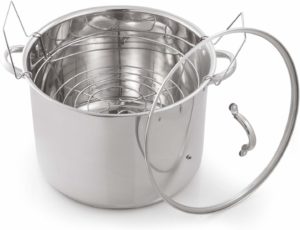
McSunley Medium Stainless Steel 21.5-qt Water Bath Canner (Amazon)
Once the water reaches and maintains a boil (212-degrees), the jars are processed for the amount of time called for in the recipe. This will destroy molds, yeasts, and bacteria to give you a safe product. Pressure canners are used to process low-acid foods, such as meat, carrots, beets, turnips, asparagus, and green beans. It looks like this:
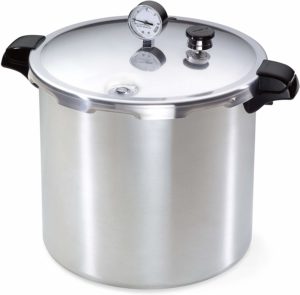
Presto 23-Quart Pressure Canner and Cooker (Amazon)
Since the steam inside of these canners is pressurized, they can maintain a temperature of 240-degrees. This safely destroys bacteria in foods that don’t have the natural acid to guard against certain kinds of bacteria growth. I personally just stick to water bath canning, as I am comfortable with the process and my family prefers these foods anyway. I just blanch & freeze low-acid foods. There’s definitely room to pick and choose what fits your interests & tastes.
Q: What supplies do I need to start canning?
A: For more details on this topic, check out our post on Water Bath Canning: Collecting the right equipment.
Q: How should I label my jars?
A: If you are into form, there are tons of great label options available (Amazon). These are perfect if you are planning to give canned goods as gifts. For those interested in function, a Sharpie marker to the jar lid works just fine.
COST
Q: How do you buy all the canning equipment without spending a ton of money?
A: There are many inexpensive ways to build up your stock of canning jars and equipment. Keep your eyes open at thrift stores and garage sales. Check Craigslist. Ask your neighbor or relative who no longer cans. Watch for deals at the end of the season. Some community organizations even loan out canning equipment for a small donation!
With the exception of lids, your canning supplies can be re-used for years. The initial investment will pay for itself over time.
Q: Is canning cheaper than just buying cans of fruits or vegetables at the store?
A: There are obviously many variables to this, as it depends on what you paid for your canning supplies and produce. But I’ll take peaches as an example. Last year I picked peaches for $.50 per pound (I try to pay no more than $.70/pound for canning produce). One quart holds about 2.5 pounds, round up for supplies and processing, and each quart cost around $1.50.
A can of peaches from WinCo might be cheaper, but that’s not a fair comparison. A closer match would be whole canned local fruit in glass jars, which is closer to $4 to $6 per quart! And the fact that the quality is so superior to anything I would buy in the store makes it an easy choice for me.
THE BASICS
Q: What types of recipes and foods are good for beginners?
A: I would master water bath canning first. Jam is a great place to start for beginners. Then move to applesauce or fruits like cherries, peaches, or pears.
Q: How do I keep my kitchen from becoming a disaster zone?
A: I just resign myself to the fact that my floors are going to be sticky, my cabinets are going to be splattered, and my table is going to be covered with produce from late August to early October. It kind of comes with the territory. However, I do try to minimize the mess to maintain my sanity.
Before canning, I clear away all clutter and clean the kitchen. While canning, I keep a big bath towel on the floor and smaller towels on the counter to catch spills or wipe up messes. I also place all my jars on a rimmed baking sheet while I am filling them and just give the sheet a quick rinse in between batches. I keep all my canning supplies (except jars) organized in a 3-Drawer Storage Cart (Amazon). It is stored in the garage most of the year and moves to the kitchen for easy access while canning.
Q: How can I get rid of all these fruit flies?
A: To keep the fruit fly population under control, fill small straight-sided dishes halfway with apple cider vinegar and a tiny drop of dish soap (to break the surface tension). Also, move produce scraps from the kitchen to the compost bin as soon as possible.
Q: How can I pull off a marathon canning session?
A: My favorite way to do big batch canning is in a group. This year, I canned 101 pints of salsa with four other people. That is a ton of roasting and chopping and stirring. At the end of the day, we each walked away with about 20 pints of salsa! There is no way I would have been able to process that many jars on my own in such a short amount of time.
If I am on my own, I clean my kitchen, clear out the kids, and prep as much as possible ahead of time. Also, by keeping everything as hot as possible, you won’t spend as much time waiting for the canner to heat up in between batches.
SAFETY
Q: Will I kill myself with exploding jars?
A: No. Canning jars are not ticking time bombs, waiting for some unsuspecting soul to try filling them with food. They are just jars. The most common cause of jars breaking are rapid changes in temperature.
For example, if you try to put cold jars in a canner full of hot water or hot jars onto a cold counter top they will break. When jars burst in a water bath canner, it’s not a huge explosion. You will probably hear a pop and see fruit floating in the canner, with your sad little broken jar bobbing around on top. The best way to avoid this is to keep your jars hot going into the canner and to have a rack or towel on the counter in a draft-free spot for your jars after processing.
Q: How long should the food in my jars last? Is there an expiration date?
A: Store your jars with the rings removed in a cool, dark place. The food will keep for a long time, but you will probably notice a decrease in the quality (flavor, texture) after one year.
Q: I want my kids to learn how to preserve food with me. How can my kids help?
A: If you have younger kids, canning is not the place for kitchen helpers. There are just way too many hot and heavy objects. Plus, the goal in canning is to move quickly and efficiently which doesn’t exactly work with little people. I usually can during naps or bedtime. If your kids are older, they could wash, sort, and peel fruit or prep lids and rings. Or make you a sandwich.
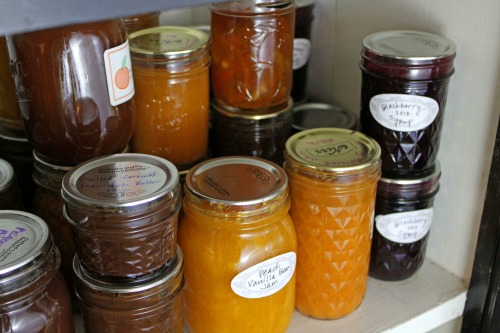
INGREDIENTS
Q: What are the best low sugar/no sugar jam recipes?
A: My favorite way to achieve low sugar or no sugar (low amount of any sweetener) jam is by using Pomona’s Universal Pectin (Amazon).
Q: Do you have to add sugar when canning fruit?
A: Sugar or other sweeteners are not necessary when canning fruit or fruit sauce. The purpose of sugar is to preserve color, texture, and flavor. You can certainly use water instead of a syrup, but from what I’ve read, you probably won’t enjoy the taste too much as canned fruit loses its sweetness during the canning process.
You can use unsweetened fruit juice instead of a sugar syrup (grape and apple juice are good options) or honey. These ingredients will give the fruit a different flavor and texture; add spices or citrus peel to enhance the flavor, if you want. When canning applesauce, I like to do a combination of apples and pears. The pears give the sauce sweetness without added sugar.
Q: What’s the purpose of Fruit Fresh or other citric acids? Is it absolutely necessary?
A: These products prevent your fruit from darkening in between cutting the fruit and filling the jars. They are optional.
CANNING RECIPES AND RESOURCES
- How to can blackberry syrup
- How to can peach vanilla bean jam
- How to can tomatoes
- How to can peaches
- How to can apple pie filling
- How to can sweet cherries
- Water Bath Canning – Step by step guide
Looking for more?
Follow Frugal Living NW on Pinterest!
Fantastic range of boards from best recipes and tips for frugal living to gardening and budgeting help.
This post may contain affiliate links. See the disclosure policy for more information.
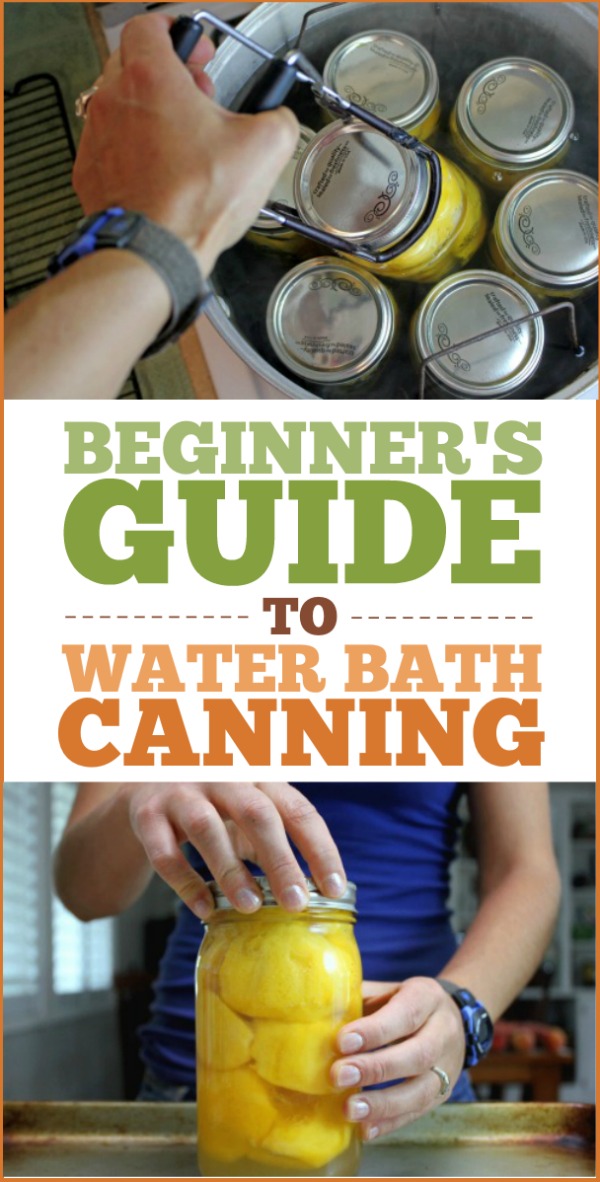

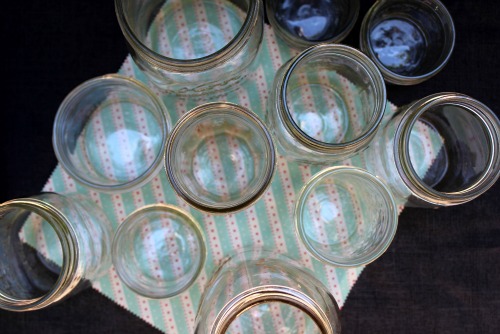
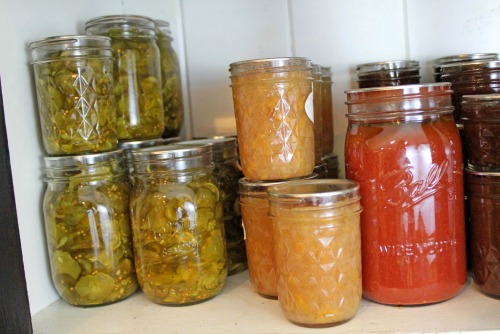
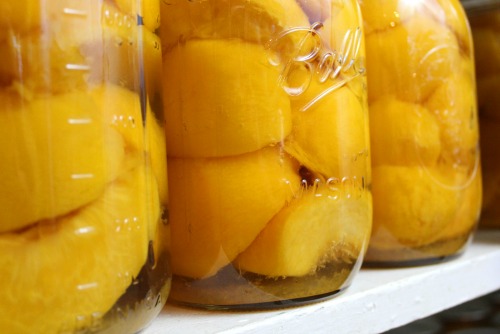
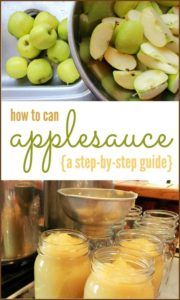

When storing, why do you remove the rings?
I have enjoyed canning for over 50 years. We always had a garden when my children were growing up and I taught them as much as I could. Their grandfather and grandmother on their fathers side always had a garden if possible….It is so relaxing to work in the soil and gardening is very rewarding…The young people now, just miss out on so much ……
I am a first time canner. I am planning on canning a pepper and tomato sort of relish. It has hot pepper, diced tomatoes, and onions which are all cooked together first. I used to freeze it but am getting a lot of freezer burn. My question is do i need to add any preservative before I seal/can the jars?
Put canning salt, teaspoon to a pint…..
I have a couple different canning questions:
#1 How can I tell if it’s time to replace my lids or rings? The lids I have are several years old, varying in seal thickness, and some have slightly warped edges from (usually) the kids trying to open the sealed jar with a knife. The rings I have are also years old and some are becoming rusty colored in the crevises.
#2 What is canning salt and when should I use it? And what is the difference between canning and pickling salt?
Thanks!!!
Lids cannot be reused unless you have purchased special lids like Tattler. I get rid of rings when they are getting rusty or if they are warped/dented. I can’t help you with your other questions though.
I never reuse lids and if the rings get rusty or twisted out they go…..canning salt will out cloud but regular table salt will become cloudy…..
I’m a beginner canner and am wondering how do u keep the jar hot before putting them in the pressure cooker? The dishwasher or pot on the stove?
Either of these options work — run the dishwasher and keep it closed until you’re ready to use them or keep them in a pot of hot (not boiling) water.
Pot on the stove, I get them in the boiling water also rings and lids
I am trying to find a recipe for water bath canning corn and clam chowder. If you have one or know where I can get one please let me know. Thank you for having this sight.
Check Ball canning web site
I have been canning for 2 seasons now. I understand the importance of keeping jars hot while filling but I get stressed out trying to hurry while filling my jars. Especially if I have a big batch. My question is, once I start filling the jars with hot liquid or food should I put in canner rack above water while filling the rest of the batch?
Get the water you are putting them in hot……fill jars put in hot water. It is much better to not do larger batches try to keep them small.
Why do you store the jars without kids.
Sometimes lids can pop open during storage, allowing bacteria and mold spores to get into the food and making it not safe to eat. Storing without rings allows you to see that the seal has popped and you know that jar is not safe. If you store with the rings, sometimes the lids will reseal themselves but the food is still not safe.
When I’m making jam, I notice it tends to seperate as it cools. Is there anything i can do to prevent this? I tried to flip them once but the jelly became runny…
Great article for beginners. Only my second year canning, but these are the things I learned and was concerned about when I first started. Thank you for writing this.
I water bathed my applesauce but I didn’t have the water over the top of the jars but they sealed and I did the test like you said taking off the rim and holding the lid will I be okay ?
Does anyone have any suggestions for where I might find a great price on a large quantity of tomatoes for canning in the Portland area? TIA!
I’ve had a great experience with Growers Outlet in SE PDX. I’ll email you another option.
I just wanted to thank you for this article and the other canning and freezing articles on this site.
I’m a newbie to canning. I’ve been canning the best bread and butter pickles for 3 years, I can over 50 pints for xmas gifts. (I add baby carrots and Walla Walla onions to them and they are a great hit!) But I’m intimidated by pressure canning so I’ve been just making my sauce and freezing it. The freezer is full because I love to garden and in July I’m constantly shelling and freezing peas and then the tomatoes start. From recent articles on your site I feel confident enough to start water bath canning the rest of the tomatoes because they are still coming!
I’m just now catching up on all your newsletters because I’ve been so busy in the garden and the kitchen. The best part was your tip on controlling the fruit flies!!! Thank you. I stopped reading and went out to fill a dish with apple cider. Then I read the comments and saw the red wine tip. What the hell? I went back to the kitchen and poured a dish of a decent Beringer red cab.
Keep the food preservation tips coming!
Does anyone have a no-sugar/really low sugar grape jelly recipe? I prefer the fruit taste to the sugar taste!
Does anyone have any good recipes for salsa to can?
I come from long lines of canning. It skipped my mom! lol So I was self taught. My family lives on a homestead and we can EVERYTHING! My gift of the year was the american pressure canner that will fit 36 jars! YUP! Its fantastic!!! Broth… no problem… veggies of whatever you want… no problem… spaghetti sauce, chili, soup starters? NO problem! Once you realize your canner is like another arm for us moms… you will be providing food for your families that are highly superior than anything you can buy in a store… tuna fresh off the boats? salmon? any meat? can it up… Because… you CAN! 🙂 Enough of this… its chili verde time and tomato sauce time…. here we go.. 🙂
Does anyone have recommendations for a good jar rack? I can’t ever get the jars to stay completely upright and they always end up tilting slightly, especially after boling for the required time.
Great post! As stated in the post, ascorbic acid (vit.c), which is in Fruit Fresh, is not necessary. However, for water bathing tomatoes, citric acid is crucial because it ups the acid to prevent botulism. Lemon juice or vinegar also work for this (see Ball Blue book for amounts).
Canning is all about common sense and paying attention to your canning. Old canners were scary and I remember my grandmother telling interesting stories about canning in the wood heat oven and on a hot stove. I recommend all those new to canning to follow the latest ball canning guidelines on each food that you are canning. I have been canning since I was a girl with my mom. I do allow my kids to help, just not when the pressure cooker gets going. I also recommend that you be careful buying old jars, that is why they break. No really old jar should be put in a pressure canner, it will break. This is great info for a beginner, thanks for all that you post.
My family’s fruit flies prefer red wine (two buck chuck) in a small custard dish to apple cider vinegar.
One trick my family has used for years is to vacuum up fruit flies at the end of a canning session.
I’m not sure why people are so scared of pressure canning? You can’t blow anything up if you have a good gasket on the lid, put the lid on correctly, and keep an eye on the pressure while you’re processing. Home canned green beans and carrots are far superior to anything in the store. The only downside is it takes longer to pressure can because you have to build pressure, keep it at pressure for the required time, then let the pressure completely drop on it’s own. It can be a 2+ hour processes sometimes, but again, it is definitely worth it to me. Just jump right in a try it!
I do most of my canning without any added sugar or sweeteners and have not noticed the decreased sweetness compared to fresh fruit taste, but it is definitely much less sweet than traditional canned fruit. So if you are fine with the unconcentrated sweetness of fresh fruit then you may want to try canning with water. Also, I tend to let my fruit get to a very ripe, but not mushy state before canning, so they are as sweet as possible.
Tried my first batch of pressure canning last year, green beans because I was given a huge amount by my father-in-law but didn’t have freezer space. It was a little nerve wracking (didn’t want to blow up the house or poison my family). I read the instructions multiple times to make sure I did every step properly but they turned out great; so much better than store bought. And now that I’ve done it, it’s not that much different than water bath and no longer scary. So if you are an experienced canner, it could be a fun challenge.
That is a really great tutorial!
I have been canning jams for many years, but never “bothered” with anything else until this year. Our garden is exceptional (great weather for it) so I canned Dilly Beans, Salsa, and Peaches (that I got a good deal on) Froze corn, some of the peaches, green/yellow beans and green peppers.
Like you, I have never done pressure canning. Always got the “you’ll blow up the house” from my M-I-L 🙂
I am hoping to expand my horizons next year and do more! It is a lot of work, but worth the time and effort in delicious, high-end products.
Bi-Mart has the 21 Quart Porclain Blue Granite Canner on sale right now for $14.99 !
The canner is black – with the rack 🙂